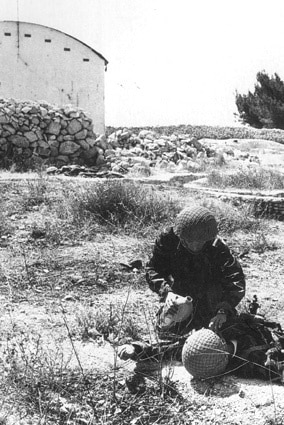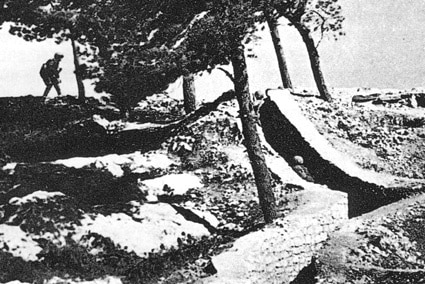This time we will tour Jerusalem, at a key site related to the Six-Day War, a war that had dramatic ramifications upon the geopolitics, economics and security in our region. The heroic story of the battle that occurred in the place we will visit – Ammunition Hill – turned it into an Israeli symbol, and a site for “the commemoration and passing down of the legacy of the battle for Jerusalem during the Six-Day War”.
Nature of the Tour: On foot
Length of the Tour: 1-3 hours
Degree of Difficulty: Easy
Starting Pointing: Put “Ammunition Hill” (5 Shlomo Zalman Shraga Street) in Waze. It can be reached via light rail (Ammunition Hill Station) or by bus from the central bus station via Line 66, and from the Downtown Jerusalem via Line 19, 34 and 34A.
Operating Hours: 09:00-17:00 (Friday and Holiday Eve: 09:00-13:00).
Entry to the site is free of charge. Tickets may be purchased for a tour in the museum, including the audiovisual display, as well as an option for a daily guided tour. For details and prices, go to http://www.g-h.org.il/
“Ammunition Hill”: What is it Exactly?
In the 1930s, the British, who controlled Israel at the time, had established a Police Academy (which is currently in the neighborhood of Ma’alot Dafna). Next to the Academy, on a nearby hill, they established ammunition warehouses, hence the name “Ammunition Hill”.
Ammunition Hill: The Strategy of Maintaining the Mount Scopus Enclave
On November 30, 1948 (a day in the year after the UN Resolution of November 29 on the Partition Plan), the “Honest Armistice” was signed between Moshe Dayan and Abdullah El Tell, in a tete a tete meeting. This agreement divided Jerusalem into a Jewish city and an Arab city, with the dividing line being called the “City Line”.
Within the Arab city was a Jewish enclave – the Mount Scopus Enclave. Under the agreement, every two weeks a convoy would depart western Jerusalem to Mount Scopus. It was clear to Israel that in any future confrontation, Mount Scopus would become the Jordanians first target. Therefore, special emphasis was given to linking up with Mount Scopus in any plan whatsoever. The Jordanians were aware of the Israeli desire to link up with Mount Scopus and therefore established 3 outposts that guarded the road: Ammunition Hill, Givat HaMivtar and French Hill. A reinforced company of the Legion (around 120 fighters) was stationed on Ammunition Hill.
As such, Ammunition Hill became a strategic point that was addressed in every IDF battle plan, as one of the key positions on the road to Mount Scopus.
Jordan Joins the War
On June 5, 1967, the Six-Day War began in the Egyptian theater. Despite diplomatic efforts, King Hussein opted to join the war alongside Egypt and the canons of the Jordanian Legion began shelling Western Jerusalem. In the Jerusalem theater, three reserve brigades and various auxiliary forces operated:
- Brigade 16 halted the Jordanian attack in Armon HaNetziv, captured the Pa’amon Fortifications and blocked the Jerusalem-Bethlehem Road.
- Brigade 10 operated from the north to Jerusalem along the Nebi Samuel Ridge, blocking the Jerusalem-Ramallah Road.
- Brigade 55 was supposed to operate in Sinai, but the collapse of the Egyptian line in Sinai and the IDF’s rapid progress rendered their participation in the Sinai campaign redundant. The brigade was diverted to Jerusalem, there it operated in the north of the city for the purpose of linking up with Mount Scopus.
The Police Academy and the Breach
The Commander of the Paratrooper Brigade, Motta Gur, ordered the capture of Ammunition Hill and the seizure of the Sheikh Jarrah Neighborhood. The plan was to breach the Police Academy to Ammunition Hill, and that the various companies of the regiment seize various parts of the compound.
The compound was comprised of a central trench, as well as an eastern and western trench that connected in the northern side of the compound. On the southern side, there was a relatively shallow trench that connected the various trenches. The plan was simple: one company would capture the access trenches to the outpost and one company would capture the various parts of the outpost, after which the force would continue to Sheikh Jarrah. In addition, six tanks were attached to the force as backup.
Surprises in the Field: Narrow Trenches and Mistaken Identification
After arriving at the entrance structure, we will go out into the courtyard. The courtyard is on the southern side of the site. The current site only reflects the part of the outpost during the Six-Day War. The eastern trench was covered, only a few parts of the eastern trench have survived, and only the western trench remains mostly intact.
The battle began at 2:20 AM within artillery shelling of the Police Academy and Ammunition Hill. The breach of the Police Academy succeeded without a hitch, since the Jordanians evacuated the structure, upon the start of the shelling, and moved to Ammunition Hill. At the beginning of the battle, it turned out that the trenches of the compound were very narrow and that only one fighter could fire while moving, as well as the difficulty of moving through the narrow trenches for a fighter in full gear.
Company D was divided into three secondary forces: A platoon to the eastern trench, a platoon to the western trench and a platoon to the central trench. However, the darkness and chaos caused a mistake. Two platoons entered the central trench, and one entered the eastern trench. The western trench, the most heavily fortified, remained without any IDF forces. Initially, everything went smoothly. The company commander believed that the plan was working properly and announced that there is no need for the reserve. However, upon their arrival to the northern side, they discovered that the bulk of the Jordanian force was fortified on the western side. The number of dead and wounded increased with each passing moment.

In the meantime, the sun rose, and the paratroopers were exposed to the Jordanians, who fired from outside of the trench at the paratroopers in the trench. One of the commanders decided to send a fighter to cover the fighters in the trench. Israel Tzuriel sprinted out and covered his friends until his ammunition ran out, and he jumped into the trench. Naftali Cohen took his place, also covered them, was injured and extricated himself. The machine gunner Eitan Nava was sent to cover and was killed while covering them. Eitan’s actions were immortalized in the song “Ammunition Hill” by Yoram Taharlev (quoting the deputy company commander Nitzan Nir, who sent Eitan out):
“I didn’t have time to ask for a volunteer, I sent Eitan. Eitan didn’t hesitate for a moment, went up and started operating the machine gun. Sometimes he would pass me, and I had to yell to him to remain in my line. In that way we passed some thirty meters, Eitan was covering from above and we were purifying the bunkers from inside. Until he was hit in his head and fell in.”
While standing in the courtyard we look northward to the water tower, and we understand the inferiority of the IDF fighters and the elevation advantage of the Jordanians. Since staying in the open during the battle was very dangerous, we will enter the nearby western trench and move northward (up). Pay attention how narrow the trench is! If you have a backpack, try turning back without touching the walls… now imagine darkness, dust, the sound of gunfire and the screams of wounded and you can understand the physical and mental difficulty of the soldiers.

The Bunker and Conclusion of the Battle
At a heavy cost in blood, the paratroopers slowly approached the central bunker. We will proceed along the western trench to the large bunker.

We walk in a slight upward incline. When we get to a 3-way junction, we will turn left and wind along the trench rightward. Please note the “rabbit warrens” (firing positions along the perimeter trench in which we are walking) in which the legion soldiers had been fortified. Every “rabbit warren” was captured after fierce resistance. As we walk along the trench we will occasionally peek outside. On the right we see bullet-riddled water tower, and further on we will see the monument for the IDF soldiers who fell here. We will look at our leisure but during the battle, anyone who raised his head risked being hit immediately. After several tens of meters of slow walking in cramped confines, we will reach the main bunker.
The bunker was a machine gun position made of fortified concrete 40 cm thick, and its structure was a room within a room. Therefore, the grenades tossed into the bunker did not eliminate those within, who would simply move to the inner room, and would return to fire after the explosion. An attempt was made to hit the bunker using two “bazooka” rockets (an antitank weapon), but as the words of the song “Ammunition Hill” tell us,
“We decided to try to blow their bunker with a bazooka. The bazooka left a few scratches on the concrete.”
The request for assistance from the tank was refused, since the tank was unable to lower its cannon to the desired angle. It was eventually decided to blow up the bunker and everyone in it. With great effort and under fire 16 kg of explosives were placed near the bunker. The explosives did the trick, the bunker blew up and the battle had ended. Although the force was harassed by gunfire from Givat HaMivtar, forces from brigade 10 captured the outpost on Givat HaMivtar and paralyzed the sources of gunfire. On the day after the battle, a company of Magav had arrived and retook the outpost, while gathering 60 Jordanian POWs.
36 IDF soldiers gave their lives to capture and Ammunition Hill. 15 soldiers received commendations.
Song:
“Ammunition Hill”, Lyrics: Yoram Taharlev, Music: Yair Rosenblum.

